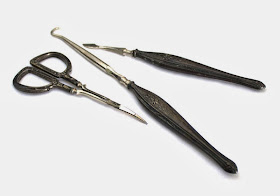 |
| Easily Made Flowers for Decorations |
Whether you are decorating your bonnet or creating a centerpiece for your Holiday table, these crepe paper flowers will surely impress. These patterns include directions to make quite realistic flowers including Chrysanthemums, Wistaria, Calla Lilies, Hyacinth and Roses, to name a few. Made as single stemmed flowers or strings of garland, like my favorite flower and vine Periwinkle. It's not just that I love it's playful name, the color is almost impossible to describe. Not blue, not lavender... it's Periwinkle!! Get the Pattern HERE.
This 1934 Newspaper article shows how to decorate tin cans with crepe paper flowers for an elegant table decoration.
We are all familiar with the red crepe paper poppies distributed on Veteran's Day. Their origins trace back to 1918 and are still made by disabled veterans as therapy and sold to generate funds to continue the process of rehabilitating our brave veterans. You can read more about the Memorial Day and Veteran's Day poppies at The American Legion Auxiliary website. But the story of how the poppy became the symbol of the blood of soldiers is a moving one and I post a snippit of it here in hopes you will read more and think twice before passing by that decorated veteran with the little red flowers.
In Flanders Fields
In Flanders fields the poppies blow
Between the crosses, row on row
That mark our place; and in the sky
The larks, still bravely singing, fly
Scarce heard amid the guns below
Between the crosses, row on row
That mark our place; and in the sky
The larks, still bravely singing, fly
Scarce heard amid the guns below
We are the Dead. Short days ago
We lived, felt dawn, saw sunset glow,
Loved, and were loved, and now we lie
In Flanders fields.
We lived, felt dawn, saw sunset glow,
Loved, and were loved, and now we lie
In Flanders fields.
Take up our quarrel with the foe:
To you from failing hands we throw
The torch; be yours to hold it high
If ye break faith with us who die
We shall not sleep, though poppies grow
In Flanders fields.
To you from failing hands we throw
The torch; be yours to hold it high
If ye break faith with us who die
We shall not sleep, though poppies grow
In Flanders fields.
–Lt. Col. John McCrae
The poppy, as a memorial flower to the war dead, can be traced to a single individual, Moina Michael. She was so moved by Lt. Col. McCrae's poem, "In Flanders Fields," that she wrote a response:
. . . the blood of heroes never dies
But lends a luster to the red
Of the flower that blooms above the dead
In Flanders' Fields.
On impulse, she bought a bouquet of poppies – all that New York City's Wanamaker's Department Store had – and handed them to businessmen meeting at the New York YMCA where she worked. She asked them to wear the poppy as a tribute to the fallen. That was November 1918. World War I was over, but America's sons would rest forever "in Flanders' Fields." Later she would spearhead a campaign that would result in the adoption of the poppy as the national symbol of sacrifice.
_____ from the American Legion Auxiliary Website

















































